Abstract
During the last decade, different concepts, methodologies, and technologies have appeared, evolving industry toward what we know today as the fourth industrial evolution or Industry 4.0 (I4.0) and Advanced Manufacturing (AM). Based on both, Supply Chain (SC) is presented as the relevant process that sets the sustainability of manufacturing and, therefore, is defined as a key term in a sustainable approach to I4.0. However, there are no studies that analyze the evolution of science in the fields of I4.0 and AM together. In order to fill this gap, the aim of this research work is to analyze the tendencies of science research related to I4.0 and AM by conducting a bibliometric and network analysis and also to generate a new contribution through the analysis of scientific trends related to SC and Sustainable Supply Chain (SSC) within this scientific context, for the time span 2010–2019. The results show that the number of publications is growing exponentially and the most active countries are Germany and the U.S., with Rheinisch-Westfälische Technische Hochschule (RWTH) Aachen University being the most productive organization and Tecnologico de Monterrey the most collaborative. The analysis of the scientific terms allows us to conclude that the research field is in a growth phase, generating up to almost 4500 new terms in 2019.
1. Introduction
The term I4.0 refers to the fourth industrial revolution [1], a consequence of the first three previous industrial revolutions, which lasted almost 200 years, with the presence and use or implementation of the I4.0 concept now being a reality in different industrial and business environments [2].
As a prelude to I4.0, a new manufacturing model, called Advanced Manufacturing (AM), appeared in production processes during the third industrial revolution which, through creative ideas and technological processes, created innovative products [3]. This new model began to gain more strength in the scientific field from the mid-1990s [4,5], in order to respond to production volumes and increased personalized demands [6], consequently generating various Advanced Manufacturing Technologies (AMT) or Advanced Manufacturing Systems (AMS) [7].
Despite the constant evolution of AM, which is more focused on physical manufacturing technology [8], due to the needs and changes in manufacturing processes and business models, the term I4.0 was born [9] in 2011, coined by the German government and focused on the analysis of data obtained through various automated and interconnected systems, designed to be of great help in decision-making processes and representing the main difference between the terms Industry 3.0 (I3.0) and I4.0 [10]. This implementation of interconnected automated systems results in real-time communication between products, equipment, and people; achieving increased productivity, flexibility, production speed, and mass customization; resulting in higher quality and productivity for companies [11]. In recent years, both I4.0 and AM, thanks to their technologies, have continued to evolve in search of production systems with which to reduce production costs and gain flexibility and productivity, while overcoming the various challenges arising from industrial globalization, customization, or product life cycle, among others [12], both being methodologies (I4.0 and AM) that improve innovation [13].
Regarding the technologies derived from this fourth industrial revolution, many industries have opted for them, but the fact that I4.0 supports the exchange of information and the integration of Supply Chain (SC), along with the synchronization of production with suppliers in order to shorten delivery times and reduce information desynchronization or distortions [14], has brought both manufacturing and logistics industries to the forefront in adopting or incorporating these new technologies [15]. Consequently, the automated processes and digitization derived from I4.0 have generated various impacts on both SC and, subsequently, the Supply Chain Management (SCM) structure [16]. Ojo et al. [17] defines SC as “a network of organizations responsible for the production and distribution of products from conception to the final consumer”. SCM is the integration and incorporation of all activities generated by the SC, improving relationships along the SC, thereby achieving a sustainable competitive advantage [18]. Therefore, the achievement of sustainable competitive advantages leads to a Sustainable Supply Chain (SSC), focusing on the improvement of environmental, social, and economic benefits [19], commonly referred to using a term that encompasses these three aspects: Triple Bottom Line (TBL) [20].
In view of the following, it is important to emphasize that achieving sustainability in any manufacturing company begins with SCM, and that sustainability is only achievable if it is properly managed [21], and for this purpose, the different technologies belonging to I4.0 technologies (Cyber–Physical Systems (CPS), Big Data (BD), Cloud Computing (CC), Industrial Internet of Things (IIoT)) play a very important role, under cyber security guidelines, as highlighted by several authors [22,23].
There are different analysis methods that allow us to identify the scientific evolution fundamental to an understanding of each concept of bibliometric analysis [24]. Therefore, Table 1 presents the main techniques used related to the science behind the measurement and analysis of the pros and cons of the different methods.

Table 1.
Pros and cons of the different analysis methods.
Once the pros and cons have been analyzed, the most appropriate way to define and quantify the academic performance of the defined field of research is through a bibliometric analysis of the data obtained from a scientific database. In addition, the most appropriate technique to identify the main groups of collaboration or the main fields of research, both of a specific organization and in general, is the analysis of networks, which generates relevant information for the scientific community.
A bibliometric analysis is a well-established method used to measure publications in a particular area of scientific research [36], thus allowing us to better understand scientific research. In addition, it contributes to the inspection, organization, and analysis of vast amounts of data and identification of models, thus helping in the decision-making process [37]. According to Cobo et al. [38], the most outstanding and productive topics and areas, as well as the subfields with the greatest impact, can be detected through such analyses. Moreover it is considered a tool for assessing the academic quality, productivity, and influence of a topic or area [39]. Therefore, in order to delve deeper into the different terms of I4.0 and AM, we conducted a bibliometric analysis to identify scientific research tendencies, noting that there is no bibliometric analysis that covers the joint fields of I4.0 and AM, and to analyze the scientific behavior of the SC in this context. Only a few bibliometric analyses are observed, which study the terms referring to I4.0 and AM separately. Muhuri et al. [40] performed a bibliometric analysis along with a detailed overview of I4.0 between 2012 and 2017, which is very similar in terms of date range to the analysis performed by Cobo et al. [41], whereas Mariani et al. [42] carried out a bibliometric analysis between 2011 and 2018 with reference to I4.0, focusing exclusively on the areas of business, management, and accounting, decision sciences, economics, econometrics and finance, and social sciences. More recently, Kipper et al. [43] conducted a bibliometric study between 2011 and 2018 of the term I4.0 using bibliometric software. Regarding sustainability, Sierra-Henao et al. [24] presented a bibliometric analysis on sustainability and I4.0. In contrast, in relation to AM, Dezhina et al. [44] carried out a study based on bibliometrics and AMT patenting between the 1990s and 2014 in Russia.
Science mapping, also known as bibliometric mapping, is an important research topic within the field of bibliometrics [45,46]. Science mapping is generated through different and varied techniques such as quotation analysis, bibliographic coupling, or keyword co-occurrence analysis, among others, making it possible to measure or quantify and visualize the progress of the field or area to be investigated [47], thus generating knowledge through analysis of the data. Among the various methods available for science mapping is network analysis: defining networks as a set of entities that are linked by a set of connections, with the entities being defined as nodes and the connections as links, which can represent different types of unions or connections [48,49]. As well as bibliometric analysis related to I4.0 and AM, there are no studies based on network analysis related to those research areas; nonetheless, there are studies relative to mapping I4.0, such as Chiarello et al. [50] analyzing I4.0 technologies and Yildiz [51], which analyzed the I4.0 concept.
The research fields related to I4.0 and AM cover a wide technological environment in which it is important to see the scientific paths that these associated technologies are developing. For this purpose, the techniques of bibliometric data analysis allow scientific development to be researched, identifying the academic performance (trends, authors, countries, and organizations), research topics, and collaboration networks, among others, that are leading science. There are different techniques to achieve this goal (see Table 1), but it is important to choose the right one to reach the proposed objective. In addition, a review of the literature has allowed us to conclude that there are no bibliometric analyses that cover both research topics, motivating us to opt for an analysis of the scientific trends that allow us to clarify the behavior of both fields of knowledge, sometimes not very distinguished, which complicates the definition of the search that is going to be carried out.
Therefore, the objectives of this article are, on the one hand, to carry out a bibliometric analysis and a network analysis in order to ascertain a scientific profile of I4.0 and AM in order to identify the academic performance and the main research fields; and, on the other hand, at the same time, to analyze the research field related to SSC and SC framed within I4.0 and AM in order to identify and analyze the most relevant research fields associated with SSC/SC and which organizations work in the fields. Accordingly, synergies and new lines of research will be created within the scientific community with other research groups, both national and international, to produce a competitive advantage while continuing to advance throughout the I4.0-related technological environment.
2. Methodology
The objectives of the research work are achieved through the following three phases: The first is based on retrieving data in order to generate a database of scientific publications related to I4.0 and AM. Several studies state that the use of different databases (Scopus, Web of Science (WoS), and Google Scholar (GS)) produces better results. However, GS presents as many citations as Scopus and WoS, and those citations that differ or are unique have less scientific impact than those of Scopus and WoS [52,53]. Furthermore, these two databases are complementary to each other, but in this case, Scopus presents more records than WoS, which is why it has been chosen. That said, for this reason, Scopus database is used, as it is one of the largest databases of abstracts and citations in peer-reviewed literature (75 million documents indexed) [54].
The allocation was accomplished by creating and iteratively testing different queries, composed of different terms for gathering data from the database’s scientific documents. With the aim of building the main query terminology, the particular terms that occur in previous AM- and I4.0-related work were established. In the search strategy, it is very important to define the search query and find a balance between recall and precision [55]. In this case, the research field can cover different approaches, and therefore, the query was built using “Advanced manufacturing or Industry 4.0” and both, as the case may be, combined with “technology or systems or overview or key” as keywords (groups Author Keywords and Index Terms derived from Elsevier’s thesauri), in order to obtain a precise query with a greater recall (see Figure 1). The data collection time span was set between 2010 and 2019. The main query used in Scopus retrieved a total of 6571 publications.
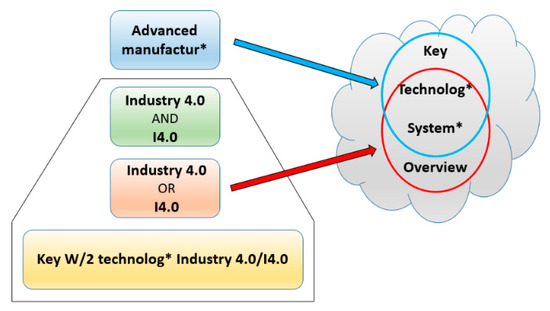
Figure 1.
Scheme Followed in Defining the Search Query. *: wildcard character with which to represent and cover any other term, within our area of study, through the different existing possibilities of the character * onwards.
The second step is the cleaning up of retrieved data, using text mining tools. For this, VantagePoint (VP) software [56] was used, a text-mining software that helps us to clean up the data and then analyze it through a combination of statistics. This software includes data cleaning tools based on fuzzy matching techniques or thesaurus, and furthermore, it incorporates techniques for analyzing data, such as co-occurrences matrix, Social Network Analysis (SNA), natural language programming, etc.
The third step is the generation of the scientific research profile, through which the publication trends, academic performance, and research topics are described. In order to improve and deepen the analysis of scientific trends, based on the co-occurrence matrices created in VP, a network analysis was carried out. The networks allow us to visualize and identify the collaborative networks between countries, organizations, the most relevant research fields in general or of a specific organization or the organizations related to a specific research area, among others. The networks were generated and visualized through Gephi software [57]. In addition, Microsoft Power BI software [58] was used to map and thus represent other results of the analysis carried out using VP.
3. Results
3.1. Scientific Performance Profile
3.1.1. General Trends of Publications
As shown in Figure 2, there has been a marked increase in the number of published documents over the last 10 years, which shows the great interest generated in the academic world, the most published types of documents being conference papers and articles. During the period from 2010 to 2014, the increase in the number of publications was gradual, and even a slight decrease occurred during 2012. However, from 2015 onward, the increase has been exponential, almost doubling year after year. Thus, the scientific and research community (and companies) is paying greater attention to the technological area as regards I4.0 and AM.

Figure 2.
No. of Document Types and Total per Year.
3.1.2. Academic Performance: Country, Organizations, and Authors
As far as academic performance is concerned, the most productive countries, organizations, and authors in the field of study were analyzed. Regarding countries, the most productive countries were Germany (896 publications), followed by the United States (U.S.) (798), China (682), and Italy (636), as shown in Figure 3. It should be noted that the U.S. and China have produced consistently over the last ten years; however, in 2014 Russia (ranked #7) started to publish the results of its research on AM and I4.0.

Figure 3.
Publication Evolution by Top Countries per Year.
In order to identify the main collaborative networks between countries, a network analysis was done. The size of the node indicates the number of collaborations, and as shown in Figure 4, the most collaborative countries are located in the core of the network and are U.S., China, United Kingdom (U.K.), Germany, and Italy. In addition, we also found other countries such as Australia (ranked #10), Mexico (ranked #12), India (ranked #13), Malaysia (ranked #16), and Canada (ranked #18), which present an important level of collaboration. Therefore, in the field of research, the collaborations are located in what is known as the tri-polar world (America, Europe, Asia-Pacific), positioning the scientific powerhouse countries in the central zone of the network, surrounded by emerging countries.
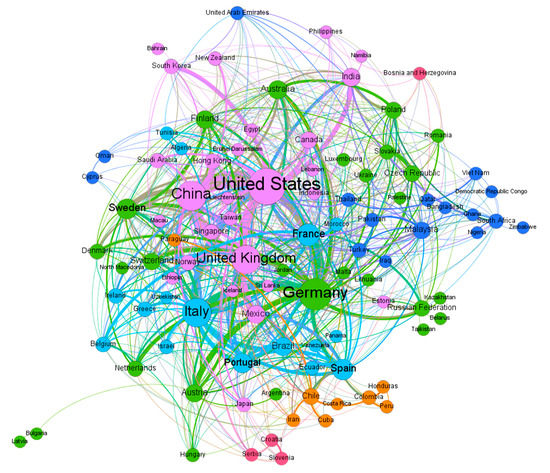
Figure 4.
Country Collaboration Network.
In order to quantify these levels of collaboration, Table 2 indicates the weighted degrees of the different countries, making it possible to quantify the number of collaborations of the different countries (the size of the node in Figure 4). Emphasizing that the most productive countries are the most collaborative.

Table 2.
Quantification of Collaboration between Countries.
In terms of organizations, the most productive organizations between 2010 and 2019 were the Rheinisch-Westfälische Technische Hochschule (RWTH) Aachen University (Germany) with 72 publications, followed by Università degli Studi di Brescia (Italy) with 53 publications, and Saint Petersburg National Research University of Information Technologies, Mechanics, and Optics University (ITMO) (Russia) with 52 publications, as shown in Table 3. However, it should be noted that the publications of Stuttgart University (ranked #6) have an average of three times more citations than those of first-ranked RWTH Aachen University, which indicates the influence that the research carried out by this organization has on the rest of the scientific community. Finally, within the Top 10, there is a majority presence of European organizations, differentiating the organizations from Russia and two American countries (Brazil and Mexico) within this ranking as non-European organizations and emphasizing the influence of the publications of the Tecnológico de Monterrey.

Table 3.
The Most Active Organizations.
The following network of organizations (Figure 5) reflects the most collaborative organizations. The University of Monterrey, despite being the tenth (ranked #10) most productive organization, is the university that produces the most articles in collaboration. Similarly, the University of Naples Federico II is active and very collaborative. In addition, the high degree of collaboration with other organizations of the University of Pennsylvania in its research work is interesting. Furthermore, South China University of Technology, Beihang University, Shanghai Jiao Tong University, and Plekhanov Russian University of Economics are very active organizations in terms of collaboration.
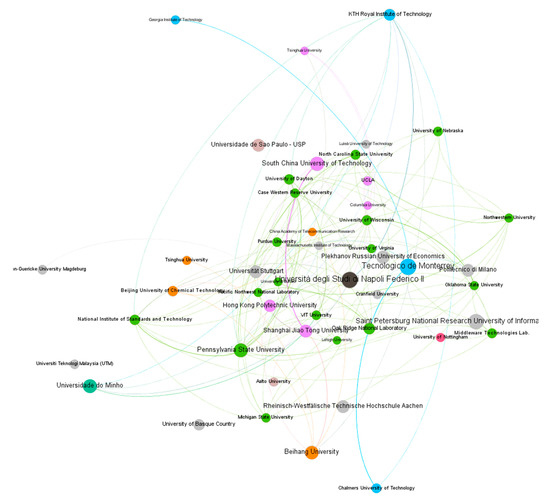
Figure 5.
Network of Collaboration between Organizations.
In regard to the organizations, Table 4 shows the degrees of collaboration between the different organizations, thus quantifying the different nodes of organizations represented in Figure 5.

Table 4.
Quantification of Collaboration between Organizations.
Regarding authors, the first three authors with the highest number of publications (Zakoldaev, Danil A.; Zharinov, Igor Olegovich; and Shukalov, Anatoly Vladimirovich), belong to ITMO University.
Despite this, their “average citations per publication” is one of the lowest in the top 10, which means that their scope or repercussion on other works and/or authors is much lower than that of Wuest, Thorsten (ranked #7); Mourtzis, Dimitris (ranked #10); or Ferrari, Paolo (ranked #8), who are more influential in this field of study.
Figure 6 shows the geographical location of the different authors observed in Table 5. The greater the concentration of authors in that geographical area, the greater the diameter of the node that represents them, with Russia being the country with the most authors in the top 10 but, as mentioned previously, with less impact. In fact, within the top 5, the author with the highest average citations per publication is located in the U.S., and the remaining four authors are located in Europe.
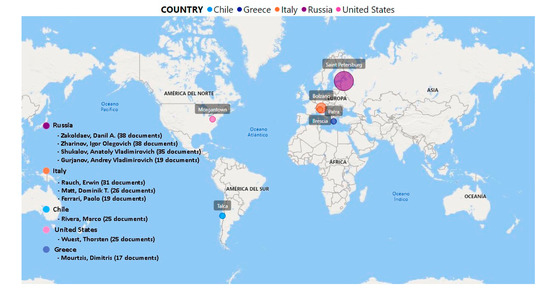
Figure 6.
Location of the Top 10 Authors.

Table 5.
The Most Active Authors.
3.1.3. Sources and Subject Area Classification
The different sources with more documents related to I4.0 and AM were identified. As shown in Figure 7, the number of documents published by the top 10 sources is about the 19.7% of the publications on this subject. For example, the journal Procedia Computer Science (ranked #1) monopolizes 3.3% of the documents published. Of the total of documents, 58.3% are published in conference proceedings and 34.3% in journals, with the remaining percentage being published in book chapters, reviews, etc. It is worth noting the importance of Procedia in the number of documents published. Procedia (Procedia Computer Science, CIRP (see footer of Figure 7), Manufacturing …) is an open source series published by Elsevier that has the purpose of publishing proposed conference proceedings. Therefore, conferences become the most important source of dissemination of scientific research related to I4.0 and AM.
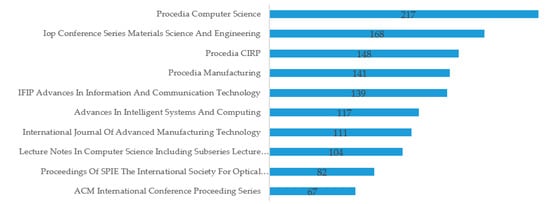
Figure 7.
Number of Publications according to Top Sources. IOP, Institute of Physics; CIRP, College International Pour la Recherche en Productique; IFIP, International Federation for Information Processing; SPIE, Society of Photographic Instrumentation Engineers; ACM, Association for Computing Machinery.
Regarding the subject area of publications based on the categorization performed by the Scopus database, the most represented areas are engineering with 30% of the publications, followed by computer science with 24% and mathematics with 7%.
3.1.4. Research Topics
Keywords are the core of knowledge in academic studies; therefore, through the analysis of keywords we can observe and identify the fields of research in development, as well as the main research topics in I4.0 and AM. In this research, 13,657 author keywords were extracted from 6571 documents, and after an exhaustive cleaning and debugging process using VP software, these were reduced to 11,530. The analysis of the number of keywords or terms that are defined in scientific research based on the first time or first year that the term appears in the dataset studied, allows us to ascertain the level of maturity of the research term. Therefore, as shown in Figure 8, two different stages can be identified: an initial period between 2010 and 2014, in which the new terms or keywords defined each year grow slowly, and a growth period between 2015 and 2019, in which the generation of new research areas grows exponentially.
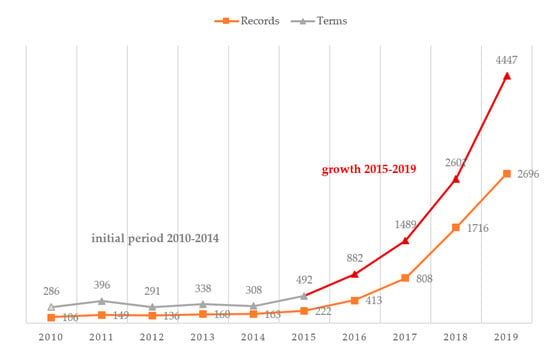
Figure 8.
Number of New Author’s Keywords in Any Year Vs. The Number of Records for that Year.
In addition, as shown in Figure 9, the network of author’s keywords that co-occur at least fifty times was plotted using Gephi, based on the matrix of co-occurrences. In the network, three clusters are identified, highlighting the main cluster (purple), which groups the largest number of terms linked to I4.0. The terms with the highest number of co-occurrences are: Internet of Things (IoT), CPS, BD, Smart Manufacturing (SM), IIoT, Smart Factory (SF), digitalization, CC, and SC. The second most important cluster (green) groups the terms related to AM, such as, additive manufacturing, Rapid Prototyping (RP), Analytic Hierarchic Process (AHP), design, and optimization. Moreover, the third (blue) groups terms related to Machine Learning (ML), such as Deep Learning (DL) and Neural Networks (NN).
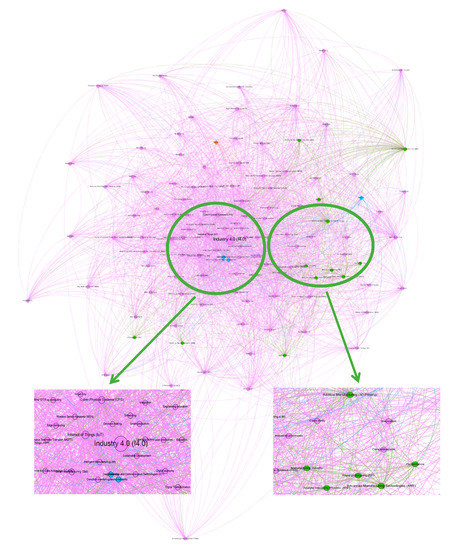
Figure 9.
Authors’ Keyword Co-Occurrences Network.
Regarding the quantification of the degree of co-occurrence of keywords, Table 6 shows the weighted degree of the main terms of the three clusters together with the degree of collaboration of the main terms of the clusters. Highlighting the high degree of co-occurrence of the cluster relative to I4.0.

Table 6.
Quantification of the Network of Co-Occurrences.
Furthermore, taking into account that the University of Stuttgart has been identified as the most influential of the top 10, a network analysis based on the co-occurrence matrix has been carried out to identify the University of Stuttgart’s main research topics (see Figure 10). The main research topics refer to I4.0, CPS, digitalization, manufacturing, data analytics, process optimization, IoT, SM, IIoT, Cloud Manufacturing (CMfg), data mining, production systems, and Petri nets, among others.
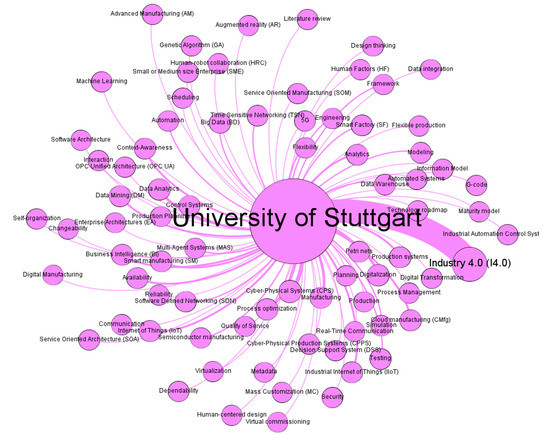
Figure 10.
Author’s Keywords and University of Stuttgart Co-Occurrence Network.
The different nodes or research topics of the network do not present a great difference in size, except in the case of I4.0, as indicated by the weighted degree of the main terms represented in Table 7.

Table 7.
Quantification of the Main Research Topics of the University of Stuttgart.
3.2. What about the Sustainable Supply Chain?
In order to analyze the academic–scientific behavior of SC or SSC in the scientific environment of I4.0 and AM, we have analyzed, on the one hand, the evolution of these terms (and others related to them) based on the first year that these terms appear in the scientific research. On the other hand, based on a network analysis, the research topics that co-occur in this area of research have been identified, and in addition, both the organizations and countries that research in the area have been identified.
Regarding terms or keywords, the first year in which the terms associated with SC appeared has been identified. As is shown in Table 8, the terms associated with SC have evolved over the last ten years, with the recent appearance (2018) of the sustainable and SC research model as the keyword “Sustainable Supply Chain”. Please note that the first reference in our SC dataset is from 2011; however, it may be earlier since a limitation of the study is that not all publications have been considered, only those published in the last ten years.

Table 8.
First Year that Terms or Keywords Related to “Supply Chain” Appear.
The recent definition of SSC as a research topic may be due to time constraints, as it is not a term that co-occurs a lot with other research topics, and this is what the author’s keyword co-occurrence matrix tells us (see Figure 9). Therefore, as shown in Figure 11, based on the network analysis the terms most influential to ““Supply Chain” are identified: sustainability, Logistic 4.0, digitalization, data mining, optimization, simulation, Decision Support Systems (DSS), process control, among others.
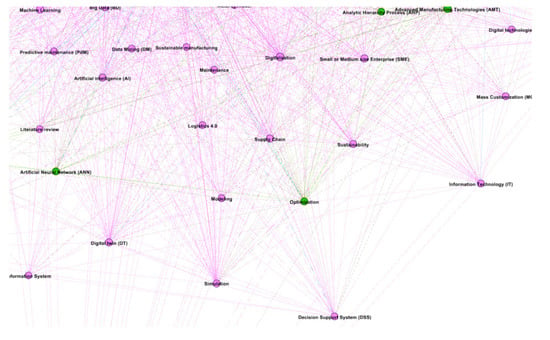
Figure 11.
Network of Terms that Co-Occur with Supply Chain.
With regard to the countries and organizations that research SC and SSC, the network analysis has made it possible to identify these (see Figure 12). The SC research field has a broad background and, therefore, its scientific development is located in America, Asia, Africa, and Europe, highlighting countries such as U.S., China, Germany, Spain, Italy, India, Indonesia, Brazil, and South Africa. However, the SSC research field has a more limited expansion, due to its brief time in scientific development (see Table 8). Nonetheless, its research is carried out in countries such as U.S., India, Spain, Iran, Lithuania, South Africa, Denmark, China, U.K., Brazil, among others.
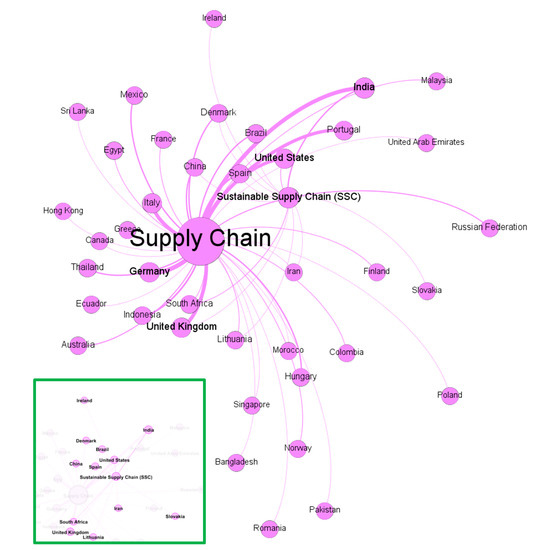
Figure 12.
SC and SSC and Country Co-Occurrence Network.
In order to identify the organizations that research in the area of SC and SSC, a network was created based on the matrix of co-occurrences of terms and organizations, most notably VIT University (Vellore Institute of Technology) of India for its research in both areas (see Figure 13). In addition, the field of SC research has a strong presence in the following organizations: Universidade do Minho, University of Bozen-Bolzano, Berlin School of Economics and Law, Chulalongkom University, and St. Petersburg Institute for Informatics and Automation of the RAS (SPIIRAS). In turn, research related to SSC is also present in University of Sevilla, Columbia University, Beijing University of Technology, and Copenhagen Center for IoT Economy, among others.
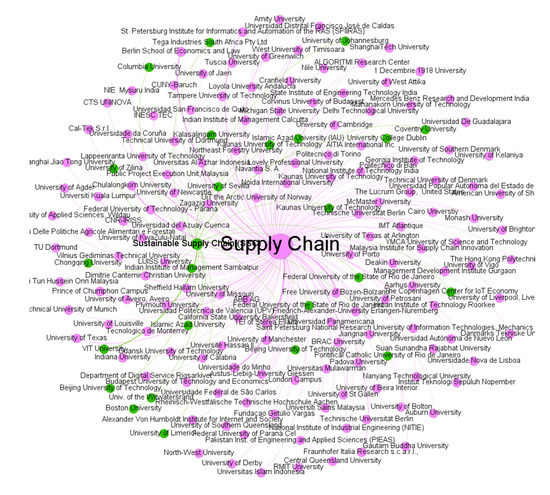
Figure 13.
SC and SSC and Organization Co-Occurrence Network.
4. Discussion
The analysis of the scientific profile adopted by I4.0 and AM shows an exponential growth of the number of publications in recent years. In addition, the study of the number of terms or research topics that appear for the first time in the time span of the dataset allows us to estimate the level of technological growth [59], concluding that the scientific field related to I4.0 and AM is in a period of growth, generating up to almost 4500 new terms in the year 2019.
According to academic performance, the most productive countries are also the most collaborative countries, creating international synergies in scientific development that are capable of uniting the four continents. The significant presence of European countries among the top 10 is worth mentioning, with emerging scientific countries beginning to occupy central positions, moving gradually toward the nucleus of the collaboration network, and the science powerhouses being located in the central positions [60]. In the case of SC or SSC research topics in the context of I4.0 and AM, the countries and organizations that develop their scientific research are located in America, Europe, Asia, and Africa and research at a very similar level, highlighting the University of Minho (Portugal) and the University of Bozen-Bolzano (Italy) as the most active, and VIT University (India) that researches both research topics.
With respect to collaborations in the spatial patterns, regarding organizations, RWTH Aachen University in Germany (the birthplace of I4.0), is the one with the highest number of publications. Nonetheless, the University of Stuttgart and Tecnologico de Monterrey should be highlighted as the organizations with the greatest scientific impact, having the highest average citations per publication despite not being among the top 5 organizations with the most publications. However, Tecnologico de Monterrey (Mexico), together with the University of Naples Federico II (Italy) are the most collaborative organizations. This allows us to determine the capacity of relation, diffusion, or scientific–technological transfer of these organizations, noting that greater collaboration and linkage (over time) between organizations contributes to above-average productivity along with greater impact on the citation impact of individual (non-collaborative) publications, resulting in additional visibility and therefore greater dissemination [61].
With respect to authors, the three authors with the greatest number of publications belong to the same institution, ITMO University (Russia), forming a research group, but the impact of those publications is low. Nevertheless, Thorsten Wuest, from West Virginia University (U.S.), stands out in terms of research impact; with an average citations per publication more than double that of the second most influential author.
In terms of publication subject area, the most represented and notable areas are engineering with 30% of publications, followed by computer science with 24%. This is not surprising, since both connectivity and digitalization, which is mainly associated with I4.0, are mainly found in industrial manufacturing sectors [62], which involve continuous engineering work and computer knowledge. In addition, the main source of publication is conference proceedings.
The network analysis of the research topics allows us to conclude that there are two main research areas grouped in two clusters, the main cluster being the one formed by the I4.0 field, in which the SC- and SSC-related topics are grouped, besides other research areas such as CPS, digitalization, manufacturing, data analytics, process optimization, IoT, SM, IIoT, CMfg, data mining, etc. The cluster related to AM group terms include additive manufacturing and RP and AHP. Comparing these topics with the works produced by other authors such as Da Silva et al. [63] and Cimini et al. [64], we can see that the topics observed in the network effectively coincide with the technological bases that the different authors use as a foundation in the process of technological and digital transformation of SC directed toward I4.0 through their technologies. Therefore, despite the fact that I4.0 and AM present the same approach to increase competitiveness in different production systems, it can be concluded that, as far as scientific development is concerned, the research fields linked to them are clearly differentiated.
In reference to SSC, as it is a relatively new term (first year 2018) in comparison with the term SC (2011), the transformation of SC into a sustainable one requires a series of decisions to be taken, accompanied by correct Sustainable Supply Chain Management (SSCM) [65], which includes environmental, social, and economic issues in order to be sustainable. Considering the adoption of these issues as a win–win situation, together with the various environmental improvements to reduce waste, resource use, and inefficiency, along with interest from governments [66], we note that the field of SSC is a very important and almost an obligatory area to work on, and will therefore open the way to future research, much of which is linked to the technologies derived from I4.0, which today, as we have seen in this study, serve as a basis for the search for sustainability in SC.
Finally, in order to clarify the academic–scientific contribution of this research work, Table 9 presents all research work that has been carried out via a bibliometric analysis related to I4.0.

Table 9.
Research Studies Related to I4.0 Based on Bibliometric Analysis.
Therefore, in addition to covering the gap indicated at the beginning of this work, through our study and analysis we are providing the scientific community new ways of collaboration, both in terms of I4.0 and AM, by representing and indicating the most collaborative and outstanding countries and institutions, determining their capacity for dissemination and relationship. Likewise, we are contributing to the identification of the scientific trends of SSC and SC, especially within the scientific context referring to I4.0 and its technologies, also identifying the countries and institutions that research more in this area, opening the way to future research and collaboration in search of greater sustainability within the manufacturing sector.
5. Conclusions
The research carried out in this paper allows us to conclude that the scientific research related to I4.0 and AM is growing exponentially, and the main active countries are Germany, U.S., and China. In addition, the scientific publications are developed collaboratively all over the world (Europe, America, and Asia-Pacific), the scientific powerhouses being the core or central part of the network, and in turn, the most collaborative. As far as organizations are concerned, RWTH Aachen University is the most productive organization; however, the articles by the University of Stuttgart and Tecnologico de Monterrey have a significant influence on scientific production, Tecnologico de Monterrey being the most collaborative organization. In terms of research topics, the network of one of the most influential universities allows us to define several main research fields relating to I4.0 technologies: CPS, digitalization, manufacturing, data analytics, process optimization, IoT, SM, among others.
Therefore, it can be concluded that this is a very active field of research, opening the way to new investigations that make it possible to further the transfer of the knowledge generated (as co-citation analysis), in order to facilitate and promote new research to the scientific community.
Due to the environmental, social, and economic improvements brought about by SSC, together with government pressure and customer demands concerning environmental matters, SSC will be a target for continuous research. Therefore, the use of technologies that have emerged from I4.0 and AM, primarily I4.0, will be essential, in fact there are already a few articles linking I4.0 with sustainability through the circular economy, with terms such as Green Supply Chain Management (GSCM) coming to fore.
Finally, Figure 14 presents the science map for I4.0 and AM, in which the bibliometric and network analysis carried out are shown (Figure 15, Figure 16, Figure 17, Figure 18 and Figure 19 represent a zoom of the different parts of the “Science map for I4.0 and AM”).
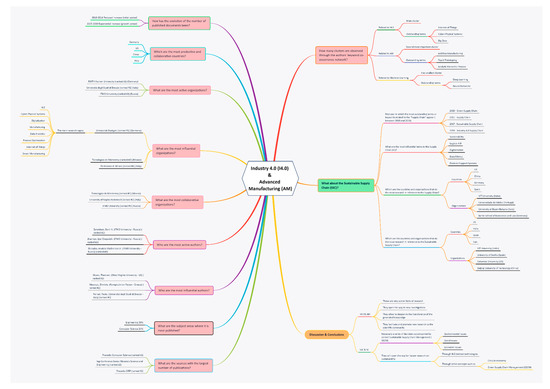
Figure 14.
Science Map for I4.0 and AM.
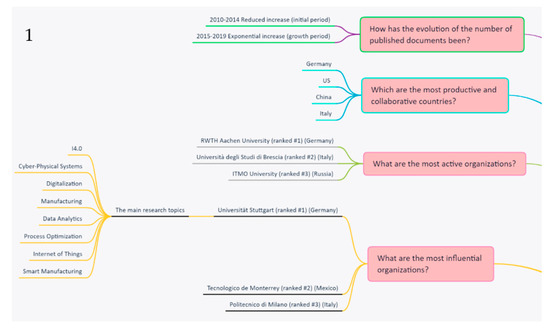
Figure 15.
Zoom of Part 1.
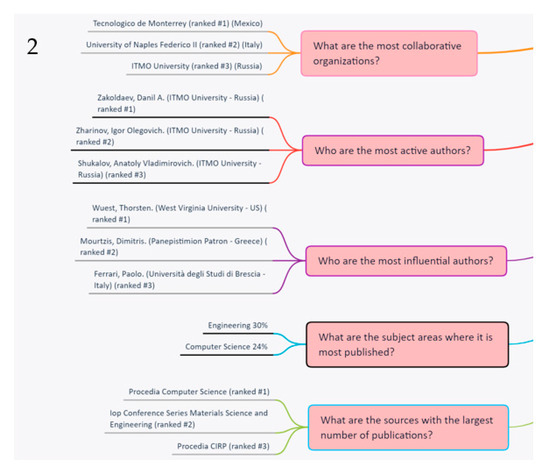
Figure 16.
Zoom of Part 2.
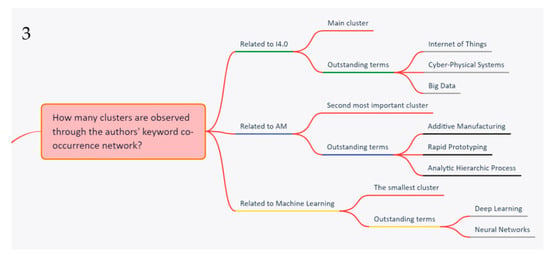
Figure 17.
Zoom of Part 3.
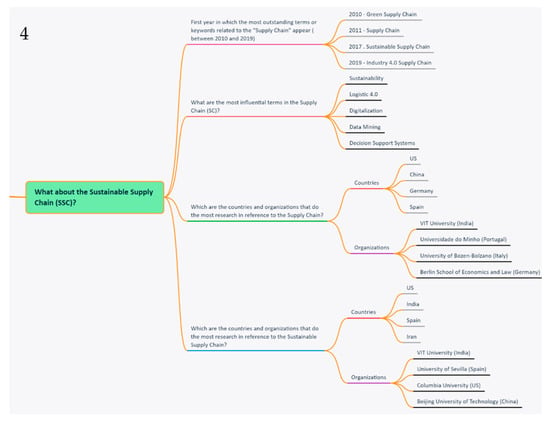
Figure 18.
Zoom of Part 4.
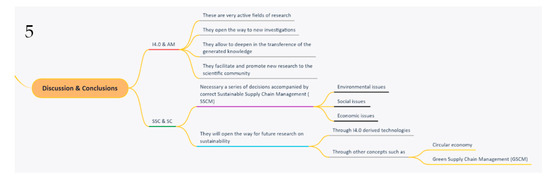
Figure 19.
Zoom of Part 5.
Author Contributions
Conceptualization, J.B.-A. and I.A.-M.; methodology, I.A.-M.; software, J.B.-A.; validation, J.B.-A., I.A.-M., and E.C.-C.; formal analysis, J.B.-A.; investigation, J.B.-A.; resources, J.B.-A.; data curation, J.B.-A.; writing—original draft preparation, J.B.-A.; writing—review and editing, J.B.-A. and I.A.-M.; visualization, J.B.-A. and G.G.-A.; supervision, G.G.-A.; project administration, E.C.-C. All authors have read and agreed to the published version of the manuscript.
Funding
This research received no external funding.
Conflicts of Interest
The authors declare no conflict of interest.
References
- Fantini, P.; Tavola, G.; Taisch, M.; Barbosa, J.; Leitao, P.; Liu, Y.; Sayed, M.S.; Lohse, N. Exploring the integration of the human as a flexibility factor in CPS enabled manufacturing environments: Methodology and results. In Proceedings of the IECON 2016–42nd Annual Conference of the IEEE Industrial Electronics Society, Florence, Italy, 23–26 October 2016; pp. 5711–5716. [Google Scholar]
- Khan, A.; Turowski, K. A Perspective on Industry 4.0: From Challenges to Opportunities in Production Systems. In Proceedings of the International Conference on Internet of Things and Big Data, Rome, Italy, 23–25 April 2016; pp. 441–448. [Google Scholar]
- Esmaeilian, B.; Behdad, S.; Wang, B. The evolution and future of manufacturing: A review. J. Manuf. Syst. 2016, 39, 79–100. [Google Scholar] [CrossRef]
- Sambasivarao, K.V.; Deshmukh, S.G. Selection and implementation of advanced manufacturing technologies: Classification and literature review of issues. Int. J. Oper. Prod. Manag. 1995, 15, 43–62. [Google Scholar] [CrossRef]
- Udo, G.J.; Ehie, I.C. Advanced manufacturing technologies. Int. J. Oper. Prod. Manag. 1996, 16, 6–26. [Google Scholar] [CrossRef]
- Santamaría, L.; Nieto, M.J.; Barge-Gil, A. Beyond formal R&D: Taking advantage of other sources of innovation in low- and medium-technology industries. Res. Policy. 2009, 38, 507–517. [Google Scholar]
- Tao, F.; Cheng, Y.; Zhang, L.; Nee, A.Y.C. Advanced manufacturing systems: Socialization characteristics and trends. J. Intell. Manuf. 2017, 28, 1079–1094. [Google Scholar] [CrossRef]
- Mittal, S.; Khan, M.A.; Romero, D.; Wuest, T. Smart manufacturing: Characteristics, technologies and enabling factors. Proc. Inst. Mech. Eng. Part B J. Eng. Manuf. 2019, 233, 1342–1361. [Google Scholar] [CrossRef]
- Rojko, A. Industry 4.0 Concept: Background and Overview. Int. J. Interact. Mob. Technol. IJIM. 2017, 11, 77. [Google Scholar] [CrossRef]
- Oliveira, M.; Afonso, D. Industry Focused in Data Collection: How Industry 4.0 is Handled by Big Data. In Proceedings of the 2019 2nd International Conference on Data Science and Information Technology, Seoul, Korea, 19 July 2019; pp. 12–18. [Google Scholar]
- Bahrin, M.A.K.; Othman, M.F.; Azli, N.H.N.; Talib, M.F. Industry 4.0: A Review on Industrial Automation and Robotic. J. Teknol. 2016, 78, 6–13. [Google Scholar]
- Müller, J.M.; Kiel, D.; Voigt, K.-I. What Drives the Implementation of Industry 4.0? The Role of Opportunities and Challenges in the Context of Sustainability. Sustainability 2018, 10, 247. [Google Scholar] [CrossRef]
- Pagliosa, M.; Tortorella, G.; Ferreira, J.C. Industry 4.0 and Lean Manufacturing: A systematic literature review and future research directions. J. Manuf. Technol. Manag. 2019. [Google Scholar] [CrossRef]
- Frank, A.G.; Dalenogare, L.S.; Ayala, N.F. Industry 4.0 technologies: Implementation patterns in manufacturing companies. Int. J. Prod. Econ. 2019, 210, 15–26. [Google Scholar] [CrossRef]
- Barreto, L.; Amaral, A.; Pereira, T. Industry 4.0 implications in logistics: An overview. Procedia Manuf. 2017, 13, 1245–1252. [Google Scholar] [CrossRef]
- Tjahjono, B.; Esplugues, C.; Ares, E.; Pelaez, G. What does Industry 4.0 mean to Supply Chain? Procedia Manuf. 2017, 13, 1175–1182. [Google Scholar] [CrossRef]
- Ojo, O.O.; Shah, S.; Coutroubis, A.D. An overview of sustainable practices in food processing supply chain environments. In Proceedings of the 2017 IEEE International Conference on Industrial Engineering and Engineering Management (IEEM), Singapore, 10–13 December 2017; pp. 1792–1796. [Google Scholar]
- Seuring, S.; Müller, M. From a literature review to a conceptual framework for sustainable supply chain management. J. Clean. Prod. 2008, 16, 1699–1710. [Google Scholar] [CrossRef]
- Bag, S.; Telukdarie, A.; Pretorius, J.H.C.; Gupta, S. Industry 4.0 and supply chain sustainability: Framework and future research directions. Benchmarking Int. J. 2018. [Google Scholar] [CrossRef]
- Elkington, J. Partnerships from cannibals with forks: The triple bottom line of 21st-century business. Environ. Qual. Manag. 1998, 8, 37–51. [Google Scholar] [CrossRef]
- Ojo, O.O.; Shah, S.; Coutroubis, A.; Jimenez, M.T.; Munoz Ocana, Y. Potential Impact of Industry 4.0 in Sustainable Food Supply Chain Environment. In Proceedings of the 2018 IEEE International Conference on Technology Management, Operations and Decisions (ICTMOD), Marrakech, Morocco, 21–23 November 2018; pp. 172–177. [Google Scholar]
- Ardito, L.; Petruzzelli, A.M.; Panniello, U.; Garavelli, A.C. Towards Industry 4.0: Mapping digital technologies for supply chain management-marketing integration. Bus. Process Manag. J. 2019, 25, 323–346. [Google Scholar] [CrossRef]
- Kozma, D.; Varga, P.; Hegedus, C. Supply Chain Management and Logistics 4.0—A Study on Arrowhead Framework Integration. In Proceedings of the 2019 8th International Conference on Industrial Technology and Management (ICITM), Cambridge, UK, 2–4 March 2019; pp. 12–16. [Google Scholar]
- Sierra-Henao, A.; Muñoz-Villamizar, A.; Solano-Charris, E.; Santos, J. Sustainable development supported by industry 4.0: A bibliometric analysis. Stud. Comput. Intell. 2020, 853, 366–376. [Google Scholar]
- Qiu, J.; Zhao, R.; Yang, S.; Dong, K. Methods of Citation Analysis. In Informetrics: Theory, Methods and Applications; Qiu, J., Zhao, R., Yang, S., Dong, K., Eds.; Springer: Singapore, 2017; pp. 207–309. [Google Scholar]
- Nakano, D.; Muniz, J., Jr. Writing the Literature Review for Empirical Papers. Available online: https://www.scielo.br/scielo.php?pid=S0103-65132018000100203&script=sci_arttext (accessed on 5 March 2018).
- Jarneving, B. Bibliographic coupling and its application to research-front and other core documents. J. Informetr. 2007, 1, 287–307. [Google Scholar] [CrossRef]
- Kessler, M.M. Bibliographic coupling between scientific papers. Am. Doc. 1963, 14, 10–25. [Google Scholar] [CrossRef]
- Small, H. Co-citation in the scientific literature: A new measure of the relationship between two documents. J. Am. Soc. Inf. Sci. 1973, 24, 265–269. [Google Scholar] [CrossRef]
- Zhan, C.; Dong, Z.; Ye, J. The evolution of keywords co-occurrence network based on MAG dataset, 1800–2017. In Proceedings of the 2018 IEEE Symposium on Product Compliance Engineering—Asia (ISPCE-CN), Shenzhen, China, 5–7 December 2018; pp. 1–4. [Google Scholar]
- Radhakrishnan, S.; Erbis, S.; Isaacs, J.A.; Kamarthi, S. Novel keyword co-occurrence network-based methods to foster systematic reviews of scientific literature. PLoS ONE. 2017, 12, e0172778. [Google Scholar]
- Chen, C.; Dubin, R.; Schultz, T. Science Mapping. In Encyclopedia of Information Science and Technology; Khosrow-Pour, M., Ed.; IGI Global: Hershey, PA, USA, 2014; pp. 271–284. [Google Scholar]
- Chen, C. Science Mapping: A Systematic Review of the Literature. J. Data Inf. Sci. 2017, 2, 1–40. [Google Scholar] [CrossRef]
- Holden, G.; Rosenberg, G.; Barker, K. Tracing Thought through Time and Space. Soc. Work Health Care. 2005, 41, 1–34. [Google Scholar] [CrossRef] [PubMed]
- Bornmann, L.; Leydesdorff, L. Scientometrics in a changing research landscape. EMBO Rep. 2014, 15, 1228–1232. [Google Scholar] [CrossRef] [PubMed]
- Garousi, V. A bibliometric analysis of the Turkish software engineering research community. Scientometrics 2015, 105, 23–49. [Google Scholar] [CrossRef]
- Daim, T.U.; Rueda, G.; Martin, H.; Gerdsri, P. Forecasting emerging technologies: Use of bibliometrics and patent analysis. Technol. Forecast. Soc. Chang. 2006, 73, 981–1012. [Google Scholar] [CrossRef]
- Cobo, M.J.; López-Herrera, A.G.; Herrera-Viedma, E.; Herrera, F. An approach for detecting, quantifying, and visualizing the evolution of a research field: A practical application to the Fuzzy Sets Theory field. J. Informetr. 2011, 5, 146–166. [Google Scholar] [CrossRef]
- Moed, H.; De Bruin, R.; Van Leeuwen, T.H. New bibliometric tools for the assessment of national research performance: Database description, overview of indicators and first applications. Scientometrics 1995, 33, 381–422. [Google Scholar] [CrossRef]
- Muhuri, P.K.; Shukla, A.K.; Abraham, A. Industry 4.0: A bibliometric analysis and detailed overview. Eng. Appl. Artif. Intell. 2019, 78, 218–235. [Google Scholar] [CrossRef]
- Cobo, M.J.; Jürgens, B.; Herrero-Solana, V.; Martínez, M.A.; Herrera-Viedma, E. Industry 4.0: A perspective based on bibliometric analysis. Procedia Comput. Sci. 2018, 139, 364–371. [Google Scholar] [CrossRef]
- Mariani, M.; Borghi, M. Industry 4.0: A bibliometric review of its managerial intellectual structure and potential evolution in the service industries. Technol. Forecast. Soc. Chang. 2019, 149, 119752. [Google Scholar] [CrossRef]
- Kipper, L.M.; Furstenau, L.B.; Hoppe, D.; Frozza, R.; Iepsen, S. Scopus scientific mapping production in industry 4.0 (2011–2018): A bibliometric analysis. Int. J. Prod. Res. 2020, 58, 1605–1627. [Google Scholar] [CrossRef]
- Dezhina, I.; Ponomarev, A.; Frolov, A. Advanced Manufacturing Technologies in Russia: Outlines of a New Policy. Foresight-Russ. Фoрсайт 2015, 9, 20–31. [Google Scholar] [CrossRef]
- Börner, K.; Chen, C.; Boyack, K.W. Visualizing knowledge domains. Annu. Rev. Inf. Sci. Technol. 2003, 37, 179–255. [Google Scholar] [CrossRef]
- Morris, S.A.; Van der Veer Martens, B. Mapping research specialties. Annu. Rev. Inf. Sci. Technol. 2008, 42, 213–295. [Google Scholar] [CrossRef]
- Gaviria-Marin, M.; Merigó, J.M.; Baier-Fuentes, H. Knowledge management: A global examination based on bibliometric analysis. Technol. Forecast. Soc. Chang. 2019, 140, 194–220. [Google Scholar] [CrossRef]
- Cobo, M.J.; López-Herrera, A.G.; Herrera-Viedma, E.; Herrera, F. Science mapping software tools: Review, analysis, and cooperative study among tools. J. Am. Soc. Inf. Sci. Technol. 2011, 62, 1382–1402. [Google Scholar] [CrossRef]
- Bruun, J.; Evans, R. Network Analysis as a Research Methodology in Science Education Research. Pedagogika 2018, 68, 201–217. [Google Scholar] [CrossRef]
- Chiarello, F.; Trivelli, L.; Bonaccorsi, A.; Fantoni, G. Extracting and mapping industry 4.0 technologies using wikipedia. Comput. Ind. 2018, 100, 244–257. [Google Scholar] [CrossRef]
- Yıldız, T. Examining the Concept of Industry 4.0 Studies Using Text Mining and Scientific Mapping Method. Procedia Comput. Sci. 2019, 158, 498–507. [Google Scholar] [CrossRef]
- Martín-Martín, A.; Orduna-Malea, E.; Thelwall, M.; Delgado López-Cózar, E. Google Scholar, Web of Science, and Scopus: A systematic comparison of citations in 252 subject categories. J. Informetr. 2018, 12, 1160–1177. [Google Scholar] [CrossRef]
- Meho, L.I.; Yang, K. Impact of data sources on citation counts and rankings of LIS faculty: Web of science versus scopus and google scholar. J. Am. Soc. Inf. Sci. Technol. 2007, 58, 2105–2125. [Google Scholar] [CrossRef]
- Elsevier, S. Scopus: Content Coverage Guide. Available online: https://www.elsevier.com/__data/assets/pdf_file/0007/69451/Scopus_ContentCoverage_Guide_WEB.pdf (accessed on 21 September 2020).
- Arora, S.K.; Porter, A.L.; Youtie, J.; Shapira, P. Capturing new developments in an emerging technology: An updated search strategy for identifying nanotechnology research outputs. Scientometrics 2013, 95, 351–370. [Google Scholar] [CrossRef]
- Search Technology the Vantage Point. Available online: https://www.thevantagepoint.com/ (accessed on 15 July 2020).
- Bastian, M.; Heymann, S.; Jacomy, M. Gephi: An Open Source Software for Exploring and Manipulating Networks. International AAAI Conference on Weblogs and Social Media. Available online: https://www.aaai.org/ocs/index.php/ICWSM/09/paper/view/154/1009 (accessed on 21 September 2020).
- Microsoft Power, BI. Available online: https://powerbi.microsoft.com/en-us/what-is-power-bi/ (accessed on 15 July 2020).
- Roper, A.T.; Cunningham, S.W.; Porter, A.L.; Mason, T.W.; Rossini, F.A.; Banks, J. Forecasting and Management of Technology; John Wiley & Sons: Hoboken, NJ, USA, 2011. [Google Scholar]
- Gui, Q.; Liu, C.; Du, D. Globalization of science and international scientific collaboration: A network perspective. Geoforum. 2019, 105, 1–12. [Google Scholar] [CrossRef]
- Petersen, A.M. Quantifying the impact of weak, strong, and super ties in scientific careers. Proc. Natl. Acad. Sci. USA 2015, 112, E4671–E4680. [Google Scholar] [CrossRef]
- Dalenogare, L.S.; Benitez, G.B.; Ayala, N.F.; Frank, A.G. The expected contribution of Industry 4.0 technologies for industrial performance. Int. J. Prod. Econ. 2018, 204, 383–394. [Google Scholar] [CrossRef]
- Da Silva, V.L.; Kovaleski, J.L.; Pagani, R.N. Technology transfer in the supply chain oriented to industry 4.0: A literature review. Technol. Anal. Strateg. Manag. 2019, 31, 546–562. [Google Scholar] [CrossRef]
- Cimini, C.; Pezzotta, G.; Pinto, R.; Cavalieri, S. Industry 4.0 Technologies Impacts in the Manufacturing and Supply Chain Landscape: An Overview. In Service Orientation in Holonic and Multi-Agent Manufacturing; Studies in Computational, Intelligence; Borangiu, T., Trentesaux, D., Thomas, A., Cavalieri, S., Eds.; Springer International Publishing: Cham, Germany, 2019; pp. 109–120. [Google Scholar]
- Wu, Z.; Pagell, M. Balancing priorities: Decision-making in sustainable supply chain management. J. Oper. Manag. 2011, 29, 577–590. [Google Scholar] [CrossRef]
- Wu, H.; Dunn, S.C. Environmentally responsible logistics systems. Int. J. Phys. Distrib. Logist. Manag. 1995, 25, 20–38. [Google Scholar] [CrossRef]
© 2020 by the authors. Licensee MDPI, Basel, Switzerland. This article is an open access article distributed under the terms and conditions of the Creative Commons Attribution (CC BY) license (http://creativecommons.org/licenses/by/4.0/).